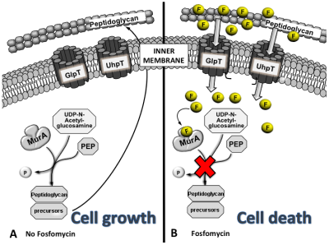Team II Comparative Genomics Group
Introduction
Background
Comparative genomics is the study of comparing genome sequences to better understand the structure and function of genes.
Fosfomycin
Fosfomycin is a natural antibacterial produced by various Streptomyces and Pseudomonas species. It is the only antibiotic currently in clinical use that targets a Mur enzyme. It is broad-spectrum bactericidal antibiotic that can be employed against both Gram-positive and Gram-negative bacteria. It interferes with cell wall synthesis, particularly inhibits the initial step involving phosphoenolpyruvate synthetase, as shown below.

Resistance of Fosfomycin involves a wide range of resistance mechanisms. Some of them include reduced uptake, target site modification, expression of antibiotic-degrading enzymes and rescue of the UDP-MurNAc biogenesis pathway (ex. mutation within MurA enzyme).
Objectives
To identify genetic determinants that could be a potential cause for Fosfomycin heteroresistance in the isolates provided.
Data
The following is the metadata of our study:
